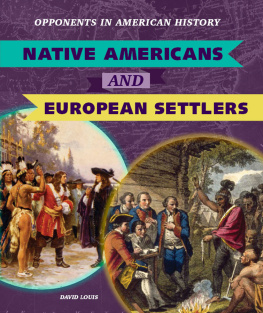Trail of Tears
A Captivating Guide to the Forced Removals of Cherokee, Muscogee Creek, Seminole, Chickasaw, and Choctaw Nations
Copyright 2018
All rights Reserved. No part of this book may be reproduced in any form without permission in writing from the author. Reviewers may quote brief passages in reviews.
Disclaimer: No part of this publication may be reproduced or transmitted in any form or by any means, mechanical or electronic, including photocopying or recording, or by any information storage and retrieval system, or transmitted by email without permission in writing from the publisher.
While all attempts have been made to verify the information provided in this publication, neither the author nor the publisher assumes any responsibility for errors, omissions or contrary interpretations of the subject matter herein.
This book is for entertainment purposes only. The views expressed are those of the author alone, and should not be taken as expert instruction or commands. The reader is responsible for his or her own actions.
Adherence to all applicable laws and regulations, including international, federal, state and local laws governing professional licensing, business practices, advertising and all other aspects of doing business in the US, Canada, UK or any other jurisdiction is the sole responsibility of the purchaser or reader.
Neither the author nor the publisher assumes any responsibility or liability whatsoever on the behalf of the purchaser or reader of these materials. Any perceived slight of any individual or organization is purely unintentional.
Table of Contents
Free Bonus from Captivating History: History Ebook
Hi History Lovers!
My name is Matt Clayton, and Im the creator of Captivating History. First off, I want to THANK YOU for reading our books in the Captivating History series. As an avid reader of History myself, I aim to produce books that will hold you captive.
Now you have a chance to join our exclusive history list so you can get the ebook below for free as well as discounts and a potential to get more history books for free! Simply click the link below to join.
P.S. If you join now, you will also receive a free Mythology book. Remember that its 100% free to join the list.

Click here to access your bonus
Also, make sure to follow us on:
Twitter: @Captivhistory
Facebook: Captivating History: @captivatinghistory
Introduction
One of the darkest and cruelest chapters in the history of the United States occurred when the nations young government decided to remove the native peoples from their lands in the name of profit. Having helped settlers for hundreds of years, five Native American tribes found it increasingly more difficult to relate to and trust the country that had once acted as their allies. The native peoples had fought alongside the Americans to gain freedom from the Kingdom of Great Britain, the nation that the colonists deemed oppressive and unfair. The native peoples acted as benefactors and teachers, helping the colonists to gain an advantage against an army that was far superior to the small forces that the colonists could muster. The new country owed a lot of its existence to the native peoples, yet the settlers, who were of European descent, did not see it that way.
Over the nearly half a century that followed the American Revolution, the actions and assistance of the native people were largely forgotten as the citizens of the new nation forgot their debt when the land of the native peoples proved to have something of value. Instead of respecting treaties, agreements, and morals, the Americans decided that they were the superior people, and quickly justified their invasion into territory that had been promised to the natives.
Tensions had been building for years as European settlers increasingly demanded more lands lands that had been used by the natives for centuries. Many reasons were given, but the truth was that gold had been discovered, and there was the potential for Americans to profit by stealing the land from the natives. Perhaps fearing retribution for the theft, but largely through religious justification of genocide, they decided to evict the natives from their land.
There were some Americans who were outraged by the actions of the government and the President, but Congress ignored the outrage, treaties, promises, and what was right in the name of enriching a few more Americans. The cruelty exhibited by the young government by removing people from their land was matched only by the cruelty and indifference many Americans felt about the hardships and misery that the native peoples suffered when they were forced to march a long way to the resettlement locations. Ultimately, it was one of the most horrific and least discussed events in the countrys history. Most people are aware that it happened, but the pain, suffering, illegality, and immoral nature of the activity is waved aside as being too far back in the history to be relevant. It is an ordeal that the native peoples never fully recovered from, especially as the country continued to push them further and further from their homes as white settlers were always prioritized over the very people who ensured that the earliest colonists were not killed by the harsh land that the settlers had adopted as their home.
Chapter 1 The Early Relationship
The relationship between the native peoples in the United States and the European settlers was initially friendly. Once the settlers were able to achieve some level of security, they began to spread and take the land that they wanted based on the idea that they were the superior race. This was decided despite the fact that they only survived those first few years because of the natives who not only helped them but also taught them how to work with the land where the settlers decided to stay.
The approach that the indigenous people took to dealing with the settlers was usually one of a teacher, and despite their reputation as savages today, the natives were largely a peaceful people who were willing to let others live as they saw fit. This was seen as a weakness by the settlers, and over the centuries they increasingly wanted more of the land they saw. Some treaties and agreements were made, but over time, the settlers, then the Americans were more than happy to disregard or discard those promises under their claim that they were superior and could take what they wanted. Sometimes their claims were on religious grounds, other times, they were more honest about the fact that they were greedy. The Trail of Tears began as a combination of both of these reasons.
Native American Lands
Of course, when it comes to talking about the native peoples, they should not really be considered as a whole, any more than a person would consider all of the settlers from Europe as a single group. Many nuances and histories are not aptly displayed with such a broad, general statement. Some tribes were more violent and less tolerant, while others were openly willing to help. Some native nations were as complex and structured as any nation in Europe at the time.
The growth and spread of colonists had been of concern to the natives by the end of the British reign of the colonies. The Proclamation of 1763 was meant to assure that the indigenous people would not lose everything to the colonists. The proclamation specified the area between the Mississippi River and the Appalachian Mountains as native lands that the colonists could not take. Once the colonists revolted against England and won the Revolutionary War, there was no guarantee that they would honor the proclamation, and in time they would prove as dishonorable as some natives had feared. Not only did the Americans fail to honor the proclamation, they repeatedly broke their own peace treaties and promises to the natives. Despite the area between the Mississippi River and the Appalachian Mountains being designated as strictly indigenous land, settlers soon started moving into it, even before the colonists revolted against Great Britain. It proved early on that the natives were never safe from the European settlers who wanted their own land and felt entitled to it, no matter what promises the governments made the natives.

















